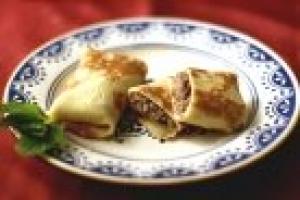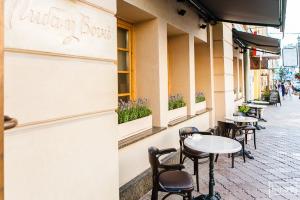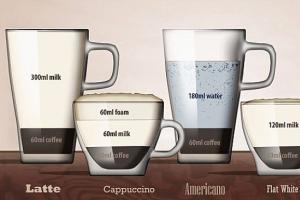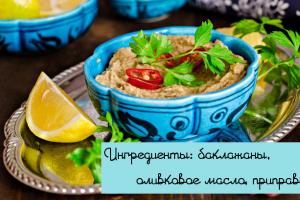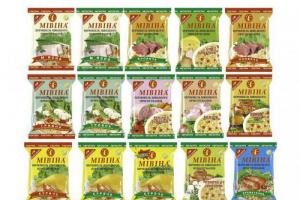Nikolay SUKHOMLIN, Kharkiv
Anyone who has been reading my articles for several days has noticed that I have to travel around the post-Soviet space quite often. And nomadic life, as you know, leaves an imprint not only on sleep, but also on the diet. From bed and fast food, and, accordingly, the selection of the menu based on the principle: what is fast is tasty. The costs of the profession, you know ...
For the first time, I became closely acquainted with instant vermicelli (noodles) in the capital of Russia. It turned out to be an excellent panacea for hunger when you feel like it, but there is no time, or on the train you enjoy an empty bottle of beer for several days.
Returning to my native Ukraine, I tried in vain to find something similar. And so it continued until 1995, when TM "Mivina" appeared on the shelves of domestic stores.
Nevertheless, despite the far from unanimous opinion, hands still did not reach to study in more detail the "peculiarities of Mivina's Ukrainian origin". The last straw was the eleventh private request on Highway regarding the "use without consequences" of Technocom's products. Geographically, the manufacturer of TM Mivina - Technocom company - is located in Kharkov, and being in the first capital of Ukraine and not sobering people up with objective information was somewhat unethical on my part. Therefore, taking with him a portion of the invariable attribute of a journalist - skepticism - I decided to dot the "i". I will not hide the fact that I myself was interested in obtaining reliable information, because after reading numerous subjective opinions on online forums, I was surprised how, having consumed instant noodles for so many years, I am still, oddly enough, still alive ...
A bit of history
Instant noodles (ramen, ramen) are specially processed (for example, fried in oil) dry noodles that can be prepared by adding hot water and the accompanying seasonings. The product is extremely convenient and easy to prepare, which makes it one of the most popular dishes in the world. In 2003 alone, approximately 70 billion servings of instant noodles were sold worldwide. In 2008, this figure was almost 100 billion servings. In general, it is believed that the first instant noodles were E-fu noodles, which appeared in the 16th century in China. It is said that the chef of the Yangzhou City Council used heavily fried noodles that could be served to guests simply by reheating them with a variety of broths. The father of modern instant noodles is Japanese Momofuku Ando, who founded Nissin Food Products Co., Ltd and organized the world's first production of Chikin Ramen (chicken-flavored) noodles in 1958.
Another milestone in this area is the introduction in 1971 by Nissin of Instant Styrofoam Cup Noodle. It can be prepared without using any utensils directly in this cup. Subsequently, dried vegetables were added to the cup, which made this dish a soup.
In a 2000 Japanese opinion poll, instant noodles were named the main Japanese invention of the 20th century. Karaoke was placed in second place, and CD - only in fifth.
Initially, the aforementioned “quick noodles” were positioned as an expensive exclusive product. It cost about 6 times more than traditional soba and udon noodles. It is now one of the most popular "speedy" products. At the same time, the price for it, for example, in the USA ranges from $ 0.7 to $ 1.6 in soft packaging (products in glasses and thermo-cups are more expensive - approx. Auth.).
Most of all in the world consume instant noodles in China (more than 50 billion servings per year), Indonesia (14.9 billion), Japan (5.4 billion), the United States (4.2 billion). And, for example, in Russia this figure is 2 billion servings per year.
The main reason for the popularity of instant noodles lies not at all in the national attitude towards the product used, and not even in the convenience and speed of preparation, which is one of the indisputable advantages of "quick" products. The main thing is to get a freshly prepared hot dish in just three minutes. Poured boiling water over - and you're done!
Skeptics should also take into account the following factor: the production technology of the aforementioned products is the same for all countries, both Asia and Europe. It doesn't matter if the consumer is in Washington, Beijing or Kharkov.
Production
It turned out to be quite difficult to get to the enterprise, where, according to the information of the company, several thousand people work. Although, however, I note, no more difficult than the "cigarette" Philip Morris. Order, discipline, to be sure, are at their best here. Having previously put on a white coat, I had to go through several mandatory procedures: special air treatment of outerwear in the cell, disinfection of shoes, etc. This is understandable - the production of high-quality food products requires strict observance of sanitary norms and rules. My guide, the head of the shop at the Mivina-3 factory, Vera Kalinina, allowed no more than a meter or a half to approach the conveyor. The reason is the same - norms and norms again.
In general, the production of products begins with the control of raw materials, which is carried out by production and technological laboratories created at the Mivina-3 factory and the factory for the production of spices and seasonings. The laboratories have an accreditation certificate from the Kharkov State Center for Standardization, Metrology and Certification. All ingredients used in the production of products are natural and only of the highest quality. Almost all are domestic ...
It is interesting to observe the very production of vermicelli up close. It would seem that it is worth making ornate products there, but no - not everything is as simple and fast as when using it.
“Here,” says Vera Kalinina, “flour and water are purified in a system of magnets and filters that trap the smallest particles of foreign matter. - The water required according to the recipe is subjected to the same cleaning procedure. The kneaded and rolled dough is cut into the finest threads, which are processed with steam at a temperature of + 120C, then the noodles are fried in palm oil. After this procedure, the vermicelli is already ready for use. Now all that remains is to dry it, cool it and pack it in special food packaging.
The whole process is so automated that sometimes the thought flashes: where are so many thousand employees ?! While I walk in parallel with the tape and the dough, going deeper into the very heart of the workshop, Vera Vasilievna tells and shows the entire technological process. Having measured in steps of more than a dozen meters, we finally find ourselves near the women-packers. Here the vermicelli is packed and prepared for further transportation. The products, ready for shipment, once again undergo duplicate quality and composition control both within the enterprises and in state control bodies.
In principle, if we talk about vermicelli, then its high quality is confirmed by the fact that products from the assembly line go to consumers in 29 countries of the near and far abroad. The only difference from the one sold on the Ukrainian market is the packaging. More precisely, its language design.
- You can't even imagine how high the requirements for product quality are imposed by European countries - says the head of the workshop V. Kalinina
- Try to bring low-quality products to Germany, Poland, and Israel, too ... Belarus has set very high demands on the "European Union" too. So the Ukrainians get the goods of the European level.
At first, I was somewhat embarrassed by the use of palm oil, which is unusual for a domestic person. Here I had to ask for clarification. According to technocom specialists, palm oil is a very nutritious and healthy product, rich in vitamins. It contains provitamin "A" 15 times more than in carrots and 50 times more than in tomatoes. And in terms of the content of vitamin E, it can be classified as one of the natural leaders.
Frying instant noodles "Mivina" in palm oil enriches the product with vitamins and gives the noodles an excellent taste and aroma. Compared to sunflower oil, palm oil is better suited for food production, since it does not form carcinogenic compounds during frying and allows you to store foods fried in it 4-5 times longer than sunflower oil.
However, sunflower oil is still present in the products. We are talking about sachets that are included in the package along with spices. As a rule, it has an amber color, excellent consistency and, for more appetite, has a delicate aroma of fresh onions. A similar olfactory effect is achieved through the use of a special technology, in which the oil is infused on onions for a certain time.
Well, if everything is more or less clear with noodles, then why does the meat in Domashnaya Mivina not spoil? As it turned out, thanks to the use in the production of a special technology called "Keep all Fresh": fresh product is cut and packed in a special way into a special metallized sealed package of 4 opaque layers. Then, with the help of special equipment, the meat can be safely stewed at a temperature of + 100C ... + 125C, under high steam pressure. Due to this, all vitamins and useful microelements are preserved in meat and vegetables as much as possible, and the shelf life of the product is also extended.
By the way, I look at the techno-com production, but I myself remember the "misunderstanding" of one friend who looked at me in surprise after reading on the packaging that the broth is made from a semi-finished meat and bone product. What it is? - he gave the question to the mountain. They also smiled at Tekhnokom - after all, they were talking about an ordinary bone with meat, which the hostesses throw into the borscht for richness.
Products and "E" with them
How many times have you convinced that our children are just right to learn the periodic table by studying food packaging. A kind of creative guide for novice chemists. And, nevertheless, our compatriots, amid general pessimism and a hot hand, will often say this. And, come on, after that figure out where the truth is and where the fiction is.
Many people think that literally all food additives are "chemistry", and therefore they are certainly harmful. To put it mildly, this is a delusion. Food additives are used to improve the quality and taste in almost every product. The only question is what kind of additives they are and how much they are used.
In 2007, at the enterprises of Technocom LLC, one of the first in Ukraine, a food safety system HACCP (ISO 22 000 certificate) was introduced, confirming the world level of quality and safety of all products. Manufacturing facilities are certified according to the international standard ISO 9001: 2000. Checkers, observers and hedgehogs with them are an integral part of the production life. And therefore, both internal and external control is carried out in such a way that, with all the desire, it will not be possible to hide the defect. And we are not talking about general "chemicalization" at all ...
Nevertheless, the questions are akin to "Where did the" white death "- salt go?", "What is monosodium glutamate and guar gum?" I asked. And I got an explanation.
"Monosodium glutamate" (lat. Monosodium glutamate, monosodium salt of glutamic acid) is a food supplement designed to enhance taste sensations by increasing the sensitivity of the papillae of the tongue. It is a white crystalline powder, readily soluble in water. Among the Chinese, it is known as "flavoring" among the Japanese as "miraculous powder" ("fe-ching"). The taste of glutamate is called “umami,” which is one of the basic taste sensations known to man. Monosodium glutamate is obtained both from natural resources and through chemical reactions. It is most often used in Japanese, Korean and especially Chinese cuisines. And received in 1907 by an employee of the Tokyo Imperial University - Kikunae Ikeda. In 1909 he was granted a patent for a method for the production of food products. It was by this method that monosodium glutamate was obtained, which began to be produced in Japan for sale under the name "aji-no-moto" - "the soul of taste". Since then, the flavor enhancer monosodium glutamate has been widely used and gained popularity all over the world. Its annual consumption on the planet has reached 200 thousand tons. So the unused salt of the Asian consumer is perfectly replaced by monosodium glutamate. In addition to which, soy sauce is also present on tables in Asia.
But guar gum is a natural thickener (like salt is a natural preservative). The gum is extracted from the bean seeds of the guar plant cultivated in India and Pakistan. Guar gum normalizes intestinal microflora, lowers cholesterol levels. Gum is often used in weight loss medications.
I don’t know how much I bothered the techno-KOM people with my questions (for the whole day, I think, they got fed up with it pretty well), but I made sure that either natural (turmeric) or additives identical to natural are used in production. In other words, a product obtained artificially according to a "natural formula" meets 100% natural requirements. And if domestic experts "accidentally" can look somewhere, then European experts, obviously, will not allow such lapses. You must admit that not all Ukrainian manufacturers can boast today that they have passed strict certification systems and that their production meets European quality and safety requirements.
However, there are two things worth considering in my opinion. Honestly, if you listen to some skeptics “from the people”, you will involuntarily come to the conclusion that it is impossible to eat at all, and even breathing air is harmful. Okay, there is society, but what about the journalists? Instead of sorting it out and going to the same Technocom (and who's in the way of asking for someone ?!), they scream in unison how bad everything is. You ask: where does the information come from? - shrug their shoulders. Because from rumors, nothing is backed up.
And, secondly, at the enterprise it is not clear why they do not carry out banal explanatory work. Until you fumble, you will not know anything. What prevents you from organizing a forum, an event where you can openly comment / refute existing misconceptions? After all, rumors are generated primarily by a lack of information. Is not it?
For reference:
ISO 9000 is a series of international ISO standards that regulate quality management in enterprises. ISO 9000 certificate is required for enterprises operating in international markets or with international suppliers that require such a certificate; working in sectors of the economy regulated by the government, or with government organizations in countries where ISO 9000 certification is mandatory. The goal of ISO 9000 is to bring consistency to the customer / supplier relationship between companies. The standard helps companies to formalize their control system for the process of checking product quality and conformity.
The HACCP system provides control at all stages of the food chain, at any point in the process of production, storage and sale of products, where violations may occur.
To implement the HACCP system, manufacturers are required not only to research their own product and production methods, but also to apply this system and its requirements to suppliers of raw materials, auxiliary materials, as well as the wholesale and retail trade system. By the way, for consumers in developed countries, the use of the HACCP system is synonymous with confidence in the safety of the purchased products.
- - sign "Highest standard" by the decision of the Scientific and Expert Council, headed by the President of the East Ukrainian Academy of Business
- 2002 - For compliance with European standards, Technocom Corporation was awarded an international diploma "European Quality" by the European Business Assembly (Oxford, UK)
- - laureate of the competition "Golden Trademark"
- - instant noodles, mashed potatoes and seasonings "Mivina ™" have received the right to be called "Product No. 1 in Ukraine" based on the results of assessing the quality and popularity within the framework of the International Festival-Competition "Choice of the Year"
see also
Links
Wikimedia Foundation. 2010.
See what "Mivina" is in other dictionaries:
This term has other meanings, see Kharkiv (disambiguation). Kharkiv city ukr. Kharkiv Flag Coat of arms ... Wikipedia
Nestlé's request is redirected here; for company founder Henri Nestlé, see Nestlé, Henri. Nestlé S.A ... Wikipedia
Instant noodles Instant noodles (ramen, ramen) are specially processed (for example, fried in oil) dry noodles, for which it is enough to add hot water and the accompanying seasonings. The product is cheap and ... Wikipedia
Instant noodles Instant noodles (ramen, ramen) are specially processed (for example, fried in oil) dry noodles, for which it is enough to add hot water and the accompanying seasonings. The product is cheap and ... Wikipedia
Instant noodles Instant noodles (ramen, ramen) are specially processed (for example, fried in oil) dry noodles, for which it is enough to add hot water and the accompanying seasonings. The product is cheap and ... Wikipedia
Instant noodles Instant noodles (ramen, ramen) are specially processed (for example, fried in oil) dry noodles, for which it is enough to add hot water and the accompanying seasonings. The product is cheap and ... Wikipedia
Instant noodles Instant noodles (ramen, ramen) are specially processed (for example, fried in oil) dry noodles, for which it is enough to add hot water and the accompanying seasonings. The product is cheap and ... Wikipedia
This article is missing links to sources of information. Information must be verifiable, otherwise it can be questioned and removed. You can ... Wikipedia
boutique- used utik; pier; Petersburg, Belarus, Ukraine sandwich Now I eat all sorts of boutiques on the plantain network, in principle, not bad, but there are few of them, mainly in the north of the city. (Petersburg) Most of all sausages and cheese are usually in my refrigerator ... because ... ... Languages of Russian cities
For the Ukrainian consumer, the word "Mivina" has long become a household name. This is what the inhabitants of Ukraine call any instant noodles. And all because this company was the first to bring to the market a product that has gained immense popularity and has managed to truly fall in love with the people. It is difficult to find a person who would not have tasted this dish at least once.
The history of this product is very interesting. Simple "curly" noodles in a colorful pack have come a really hard way, winning their market segment and their place in the heart of the buyer.
Breakthrough in the Ukrainian market
Vermicelli "Mivina" appeared on the shelves in the mid-90s of the last century. This product was not an invention, something similar already existed (for example, the inhabitants of Russia were already familiar with "Doshirak" and "Rollton"). Instant noodles belong to the traditions of the Far Eastern cuisine. It is not surprising that the citizens of the CIS were introduced to this product by immigrants from Asian countries.
In those days, many were wary of the new product, because the Ukrainians had never seen anything like it. It was difficult to believe that there was no need to cook. Many have tried these noodles for the first time out of pure curiosity.

Everyone could choose from several bright flavors. The price did not deter me. Advertising promised multiple benefits and benefits. The product was clearly not in short supply; a pack of noodles could be purchased even at a night stand. This ensured the rapid growth of Mivina's popularity. The new product also fell in love with the housewives, who, over the years of scarcity, have learned to invent delicacies from any product.
"Mivina" is a word truly dear to the heart of every tourist or student. How many times has this simple food rescued, warmed and delighted those who had to satisfy their hunger in the conditions of a campaign, a change house, a gatehouse, a hostel.
The company, introducing a new product to the market of a country that had survived the perestroika years, relied on affordability. By the way, later this played an unkind joke with the "quick" noodles: today many consider it to be food for the poor, although the cost of a portion is not so penny (for example, a portion of a potato or cereal side dish will cost less).
Compound
If you think that Mivina is a product unhealthy, pay attention to some facts. The manufacturer uses preservatives and flavor enhancers, but there are no more of them in the seasoning than in children's sweets. All ingredients are certified and quantities are within the normal range. In addition, the composition includes natural ingredients: dried vegetables, spices, vegetable oil, dried meat, sugar and salt, wheat flour. There are also synthetic additives, including those containing the letter E in the name. Therefore, Mivina is not suitable for dietary and children's menus.

The numerous awards for quality are also noteworthy.
New tastes, new products
The line of spicy and mild noodles with chicken, pork and beef flavors was soon joined by a series of Mivina spices. Powder additives with tastes of meat, mushrooms, vegetables have become real hits. Today the company also produces natural spices, consisting of dried vegetables and herbs.
Instant soups, including creamy ones, are very popular.

Set meals packed in plastic portion containers and mashed potatoes have become an excellent solution for many.
Brewing and more
The manufacturer informs about how to turn a semi-finished product into a ready-made meal on the packaging using clear, illustrated instructions. Add boiling water to the vermicelli, cover and let it brew for a couple of minutes. Mashed potatoes and most soups are prepared according to the same principle.
But Mivina noodles are not only the basis for a side dish. Many housewives prepare soups and salads with noodles.
Try kneading a briquette of noodles with your hands, adding a couple of boiled diced eggs, some ham, and pickles or fresh cucumbers. If you serve the salad dressed with mayonnaise to the table right away, the vermicelli will create a pleasant texture, the dish will be crispy. After standing and soaking, the salad turns out to be more tender. You can achieve new tastes by adding other ingredients at your discretion: pickled mushrooms, onions, herbs, peas. And if you replace the sausage with crab sticks or boiled liver, you can get a completely new snack.
Mivina's flavors make it possible to prepare a variety of soups. For example, both noodles and their seasoning can be used to prepare first courses with mushrooms, meatballs, and meat.
Precautionary measures
It should be understood that Mivina is not the best option for a daily side dish. You should not abuse fast food products. Experts assure that, if used wisely, this noodles and seasoning will not cause any negative consequences. But if there are already problems with the gastrointestinal tract (for example, an ulcer or gastritis), this product, like any hot spices, must be abandoned.
One success story
Another interesting fact related to Mivina deserves attention. The brand was created by a native of Vietnam - Pham Nyat Vyong.

Today he is a successful businessman who is the first dollar billionaire in the history of his country. Interestingly, after moving to Ukraine, Mr. Wyong ran into huge debts to give life to his brainchild. His idea quickly bore fruit, and Tekhnokom LLC, which owns the Mivina brand, became famous and rich. Later it was bought out by the Nestlé corporation for a good sum. Pham Nyat Vyong himself returned to his homeland and devoted himself to the development of business and infrastructure in Vietnam.
Random fact:
Caffeine awakens the appetite by increasing the secretion of gastric juice. Therefore, regular consumption of caffeinated beverages on an empty stomach can cause stomach problems. —
Article added by user Masha
06.07.2016
Mivina
Some people think that instant noodles have their roots in modern times of modern technology. But, as you know, the first instant noodles appear as a well-known and popular food product, which must undergo preliminary heat treatment. Instant noodles are considered pasta, which in order to cook, it is enough to pour boiling water over it and add the various spices that come with it. Today, instant noodles are one of the most widespread foods on Earth. It is famous for its cheapness, so everyone can buy it. The most widespread brand of instant noodles in Ukraine is Mivina. This trademark was founded by the Technocom corporation. In 1995, the Tekhnokom corporation, created by Pham Nyat Vyong, a resident of Ukraine of Vietnamese origin, began the production and sale of instant noodles under the name Mivina. Under the name "Mivina", instant mashed potatoes are also produced in bags and similar products, which are packed in plastic containers. In addition, this trademark is also used for sauces. Some consider the Mivina vermicelli a ticking time bomb because it contains various harmful flavorings.
Method and shelf life of this product
It is necessary to store at a temperature of no more than 30 ° C and a relative humidity of no more than 75%, the shelf life is 12 months.
Calorie content of instant noodles from "Mivina"
Energy and nutritional value of instant noodles per 100 grams of product in the ratio of carbohydrates, proteins and fats. Carbohydrates: 52.5 g. Proteins: 7.2 g. Fats: 18.4 g. The calorie content of this product is 404 kcal per 100 grams.
The composition of Mivina instant noodles
In order for the taste and aroma of noodles to be much better, it contains monosodium glutamate and other harmful flavoring additives. This additive acts as a flavor enhancer and preservative. It also includes palm stearin, wheat flour of the highest and first grade, sunflower seasoning oil (fried sunflower with onions, synthetic beta-carotene dye, antioxidant oil, a mixture of tocopherols), aroma and taste enhancers (sodium inosinate, sodium glutamate, sodium guanylate ), water, salt, sugar, dried vegetables (garlic, carrots, onions), improving the quality of pasta (stabilizers E-450, E-452, E-451, acidity regulators E-339, E-500, E-501 ), emulsifier soy lecithin, flavoring agent beef, green onions and dried parsley, turmeric, sugar color, black pepper, potato starch, dried pork meat, hydrolyzed soy protein, vegetable oil based on palm or coconut oil, stabilizer xlithelian gum, antioxidant (E-321, E-320). And also other food E-additives are included in the composition, such as: E-307, E-160a, E-621, E-627, E-631, E-322, E-150, E-100, E- 415.
The harm of Mivina instant noodles
Monosodium glutamate (E-621), which is part of this product, is made synthetically, because it is cheaper for the manufacturer. You can make it much more, it enhances and creates the taste, smell of missing meat and rancidity. Despite all this, such a supplement slightly excites the brain, is addictive and can disrupt the perception of natural products. There are other consequences, such as allergies, digestive problems, headaches, diabetes, obesity. Therefore, if the consumer is not satisfied with the contents of "Mivina", then there is no need to save on their health, because they also produce traditional noodles, which will not harm your body as much as the "Mivina" noodles.
To leave a comment, you need to enable javascript.
Discussion of the article:
/modules.php?name=articles&action=set_comment&ingr_id=4694
There are no comments yet. Will you be the first?Everyone who lived in the nineties remembers Mivina. Having barely appeared on the market, the product very quickly became popular to such an extent that the brand became an unofficial name for a product category, as, for example, any copier is now called a copier.
Schoolchildren, teachers, policemen, officials, businessmen and office workers had a snack on Mivina. This was the most affordable breakfast possible. Instant vermicelli with a taste of chicken or meat cost a penny.
Despite the low price, "Mivina" did not become exclusively a commodity for the poor. Her palatability was acceptable enough to be liked by almost everyone. From experience we can say that the situation when "you don't want borscht", but you want "Mivina" was not a rarity for Kharkiv residents.
How it all began?

The Tekhnokom corporation, which launched the production of Mivina in 1995, was founded by Pham Nyat Vyong, a native of Vietnam, who settled in Kharkov. Now the entrepreneur has become the richest inhabitant of Vietnam and is included in the list of the Top 500 richest people in the world according to Forbes magazine. His fortune is estimated at $ 4.2 billion.
According to Novoye Vremya magazine, in order to open their first business - a small budget restaurant of Vietnamese cuisine - the Vyong family borrowed about $ 10 thousand from relatives and friends. And in 1995, Vyong took out a loan at 8% per month and founded Technocom, an production of instant noodles using Vietnamese technology, calling the product "Mivina".
The products almost immediately won the sympathy of consumers. Hot noodles can be cooked in minutes. You just need to pour boiling water over the semi-finished product. Many, however, fell in love with "Mivina" even raw. For example, it was sometimes bought for beer instead of crackers.
Thanks to the ever-growing popularity of new products for consumers, its sales reached millions in 1997 already. This figure has increased every year. Due to its great popularity, they began to call any instant noodles mivina.
Having gained a foothold in the market, the Mivina company expanded its product range and in 1999 added two more novelties to its line - these are instant mashed potatoes and various types of flavoring seasonings. The expansion of products and the addition of these new products only fueled consumer interest.
Millions of Ukrainians prefer Mivina because of its good taste with notes of Vietnamese exoticism and quick preparation. Mivina is a great option when there is a need to quickly prepare hot and delicious food for the whole family.
Mivina and Nestle

In 2010, the multinational company Nestle bought out Technocom and Mivina for $ 150 million. The company has significantly increased its productivity, which made it possible to significantly expand the range and bring new types of products to the market.
Today the company produces the following food products:
- Instant vermicelli.
- Various types of instant soups.
- Mashed potatoes.
- Various flavoring condiments.
According to Nestlé, all the ingredients used to create the highest quality instant noodles, seasonings, purees and soups are always fresh and have undergone a range of special treatments.
So, for example, flour goes through a purification stage through special magnetic installations, water through purification filters that clean it from small particles and unwanted impurities. All processes are controlled in laboratory conditions.
Not so long ago, the company launched another novelty on the market - sweet "Mivina" with banana and strawberry flavors. The editors do not have data on the sale of a new product, but there is reason to believe that it will find its admirer.
I want "Mivina"

"Mivina" has already become a kind of Kharkiv meme. Kharkiv residents often remember her in conversations with each other and even in social networks.
“Based on the results of a survey of all my business acquaintances, a funny hypothesis can be put forward: those who eat Mivina at the beginning of their entrepreneurial path are 89% likely to be successful in business.
17 out of 19 respondents admitted that they had been sitting on noodles for more than one month (and some for years) after starting their business. Many (including myself) have even traced the evolution of culinary preferences - at first everyone ate only noodles. Cooked (sometimes with the addition of mayonnaise, so that It was more dangerous) or dry, crushing the noodles right in the bag, pouring out the contents of the spice bags, and shaking. Mivina puree with bits of some kind of crap and the taste of some other crap was considered a special gourmand.
At first we ate Mivina because there was no money for anything else. Then - because we immediately put all the money we earned back into business. And while our peers found work, received salaries and began to eat in cafes and restaurants (the top inaccessible to us at all), we continued to brew Mivina with boiling water.
It turns out that Mivina is not just noodles. This is a whole symbol! A symbol of hard work and big plans when there are no prerequisites for this (money dads, mothers, inheritance, etc.), except for an acute desire to do something cool at all costs. Such is the vermicelli insight 😉

And here is what the blogger writes Andrey Alyokhin whose post got almost 2 thousand likes:
“Mivina smells like dog food. It so happened that in the morning (for lack of) I had to find an old bag and brew folk vermicelli.
A lop-eared dog-unit came to the kitchen anxiously at the smell, on crooked paws, and delicately but decisively warned:
- I won't eat it.
I had to explain that I did it myself.
The dog-unit looked into its bowl with the remains of dry food for especially capricious ones and said sarcastically:
And I said:
- Very funny".



